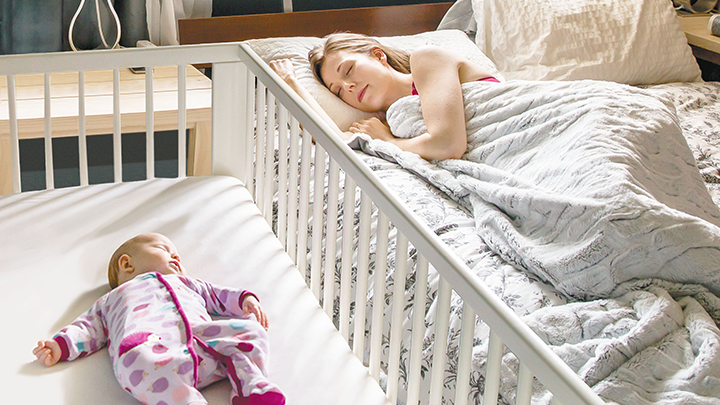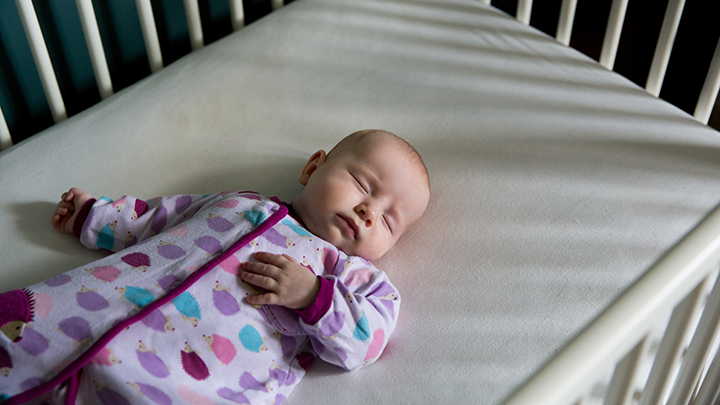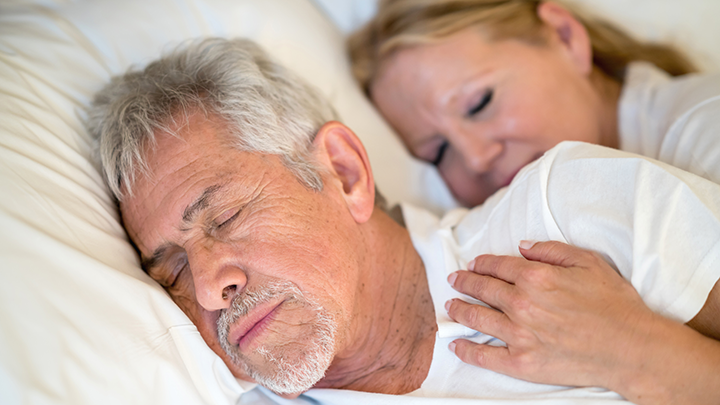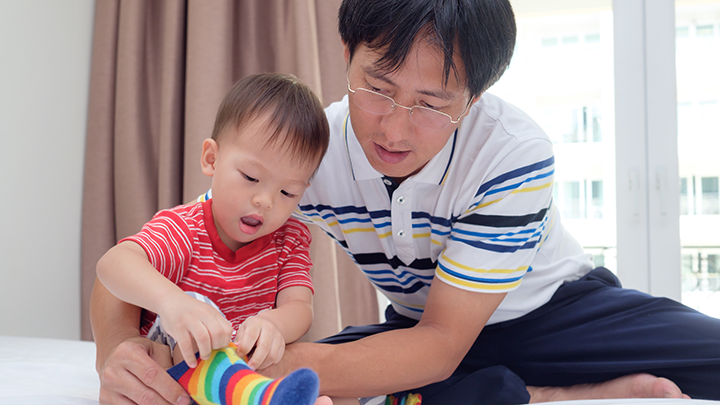
April 28, 2020

Creating a safe sleep environment reduces babies’ risk of SIDS and other sleep-related injuries.
Infants (birth to 1 year)
Toddlers (1 to 2 years)
Preschoolers (3 to 4 years)
Uninterrupted 9 to 11 hours of sleep per night for those aged 5–13 years and 8 to 10 hours per night for those aged 14–17 years, with consistent bed and wake-up times For more information on sleep for infants and children, visit Healthy Parents, Healthy Children.
Sleep is a critical biological process, and the truth is that it’s always important. When confronting the COVID-19 pandemic, though, sleep becomes even more essential because of its wide-ranging benefits for physical and mental health.
— American National Sleep Foundation

Always put babies on their backs to sleep.

Getting consistent, high-quality sleep improves virtually all aspects of health ̶ at any age.

Getting up in the morning is important — even if you’re not leaving the house. Get up, have a shower and get dressed. Follow your normal routine and get your kids out of their pajamas, too.
Family life during a pandemic can be exhausting, yet sleep doesn’t always come easy, or often enough. Changes, challenges, worries and disrupted routines can turn our sleep patterns upside down.
“Sleep is critical to your physical health and effective functioning of your immune system,” says Laura Crawford. She’s a program facilitator with Alberta Health Services’ (AHS) Healthy Living team. “It’s important for emotional wellness and mental health. Research has found getting good sleep helps reduce the risk of stress, depression and anxiety.
“These are unique times. It’s easy to see why sleep routines have been flying under the radar for families,” she adds.
As your family adjusts to this new normal and staying healthy, focusing on sleep offers great benefits to everyone. From babies right through to older adults.
Sleep refreshes and restores our bodies and minds. When you sleep well, virtually all aspects of your health can improve. Whether you had sleeping problems before COVID-19 or since, these concrete steps can help you and your family sleep more soundly.
COVID-19 has put many families under serious stress says SleepFoundation.org. “Cancelled trips, isolation from friends, and an abundance of time cooped up at home can place a strain on anyone. Keeping up with work-from-home obligations or managing a house full of children who are accustomed to being at school can pose real problems, generating stress and discord that have been shown to be barriers to sleep.”
One of the best solutions is to establish a sleep-time routine for all family members, which helps to facilitate a sense of normalcy, even in these abnormal times.
“Some of the things you can do include: set a consistent wake-up time, set your alarm, and have a routine as well for your wind-down time, which may include reading, or stretching, or meditating, or putting on pyjamas or brushing teeth.
“These days, it may also help to give yourself and your children a longer period of wind-down time. Our settling-in time is important. Pick a consistent bedtime — and actually go to bed during that time.
“Of course, small children are going to need naps. But older children, if they’re taking many naps during the day — this might affect their sleep routine. And the same goes for adults. If you’re taking a nap during the day, it could affect how easily you fall asleep in the evening.”
Eat. Sleep. Repeat eight to 12 times a day. That cycle neatly explains the general daily routine of most newborn babies.
If you’re an exhausted new mom or dad caring for a baby on such a routine, feeding your baby in bed holds a lot of charm. But you’ll want to put them back in their own bed before falling asleep. A crib is the safest place for a baby to sleep.
“Babies can fall, they can get wedged, someone in the bed can roll over on them. They can get tangled in covers. When babies are under a year old, they are little, can’t move with purpose, and can’t get out of these kinds of situations,” Crawford says.
She says many parents put their baby’s crib next to their bed to make nighttime feedings easier. This also reduces the risk of sudden infant death syndrome (SIDS) in babies under one year old.
As well, a tag-team approach to cover off the cycle of eating and sleeping can definitely help parents and baby.
To help your baby fall back to sleep after nighttime feedings, keep lights off or low and use a soft voice. And always put your baby on their back to sleep—every sleep, whether nap time or nighttime. This also helps reduce the risk of SIDS.
For more information on creating a safe sleep for newborns and infants, see Healthy Parents, Healthy Children.
Although you want a solid sleep routine for kids this age, in two-parent (or more) families, try to alternate who puts your toddler to bed. This connects the routine with sleep itself, rather than a particular person. At this age, a favourite toy or blanket may give extra security—just make sure they are safe with no loose or small parts that can cause choking. Some toddlers have night terrors or nightmares. Immediate and calm reassurance and physical comfort will likely help them go back to sleep. A night light may also be soothing. By age two, many toddlers nap once a day, after lunch.
When your toddler begins to crawl out of their crib, it’s time to move them to a bed, a change that can be eased by talking to your toddler about the more grown-up things they’re beginning to do. Remove all potential hazards to make sure your child is safe in their new surroundings.
Help your child learn that once they’re in bed, they need to stay there. A calm, consistent reminder “It’s bedtime” works best in teaching your toddler bedtime means going to and staying in bed.
For children aged five to 13, about nine to 11 hours of sleep each night gives them the energy for learning and playing. You’ll know your child is getting enough sleep when they wake up refreshed in the morning.
The Canadian Sleep Society recommends a consistent bedtime routine: a quiet, dark, comfortable place to sleep; and a sleep-and-wake schedule that varies by no more than 30 minutes, even on weekends. The society also suggests kids avoid heavy meals just before bed, although a light snack with some carbohydrates, like a half of a small apple or banana or a slice of toast are OK. Make sure your child gets regular exercise in natural sunlight. Encourage your children at this age avoid napping. Finally, make time to discuss your children’s concerns or fears earlier in the day, rather than at bedtime.
It’s also important to remember to keep your bed for rest, recharging and intimacy.
“That means not working on your bed. Not watching TV on your bed. Not bringing a laptop to bed to binge-watch movies and series,” Crawford says.
The later you stay up, the harder it is to get up in the morning. This creates a snowball effect, which means you or your children may not be tired when normal bedtime arrives. The solution is to create a daily routine.
“Getting up in the morning is important — even if you’re not leaving the house,” Crawford says. “Get up, have a shower and get dressed. Follow your normal routine for getting ready for work or going about your day. Get your kids out of their pajamas, too.”
Other good advice: Eat your meals at the same time each day. Block off times to work. Block off times to move around and go outside, especially if you have young children in the house. Be active. Go for a walk, while maintaining a safe distance from people.
“Having routines can help take away stress and make your days feel more normal — which will also help you get back into your sleep routine.”
One of the most important considerations is to be mindful of screen time.
“We know in these times that screen time is going to be higher for a variety of reasons, but we should try to limit it before bed,” Crawford says.
“For children, we would usually recommend turning screens off anywhere from two to four hours before bed. It can help with sleep. This may not be easy in these unusual times. If you can’t aim for the greatest period of time you can, ideally at least an hour before bed.”
Light affects how we sleep.
It’s important to spend some time outside in natural light every day. At night you may needs to close curtains and blinds to block out light. Let in the light in again when wake up in the morning.
“Even if the sun isn’t shining brightly, natural light still has positive effects on circadian rhythm. Many people find outdoor time is most beneficial in the morning, and as an added bonus, it’s an opportunity to get fresh air,” says American National Sleep Foundation.
Practise kindness and seek social connections to ease stress and its negative effects on mood and sleep.
“Despite all the bad news that you may come across, try to find some positive stories, such as how people are supporting one another through the pandemic,” the Foundation adds.
”You can use technology to stay in touch with friends and family so that you can maintain social connections despite the need for physical distancing.”
Relaxation techniques to get you ready for some deep Z’s include: deep breathing, stretching, yoga, mindfulness meditation, calming music, and quiet reading.
If you’re new to meditation, check out smartphone apps such as Headspace and Calm that have programs that will show you how to get started.
Relaxation and higher-quality sleep also come easier when you moderate how much alcohol or caffeine you consume, especially later in the day.